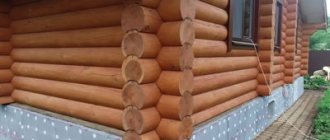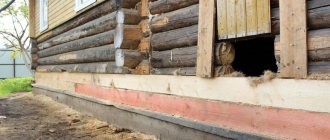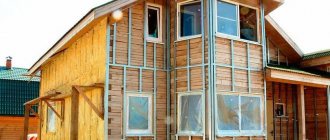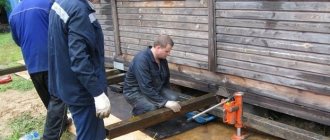Narrative plan:
- Introduction;
- Causes of foundation subsidence;
- How to avoid foundation subsidence;
- Stopping the subsidence process.
The foundation is a solid foundation for any structure. Its reliability directly affects the safety and comfort of building occupants.
During operation, a process of shrinkage constantly occurs under the influence of environmental factors and weather conditions.
Shrinkage is a change in the size and volume of a house support structure under certain conditions. It leads to the appearance of wall cracks, distortion of door and window openings, subsidence of building corners, and destruction of some structural elements.
Without action, this process can lead to the destruction of the structure over time.
What structures can be lifted
For major repairs, only one-story buildings of the following types are raised: made of wooden beams;
from rounded and other logs; panel wooden houses. Structures made from timber or hardwood, such as larch and oak, last for quite a long time. There are still houses built before the revolution, which are over 100 years old and have retained their almost original appearance.
Modern wooden buildings are not so durable. The reason for this is the quality of the timber, which became especially susceptible to various diseases after the beginning of the “atomic era” and the ongoing testing of nuclear bombs.
In this regard, wooden structures must be thoroughly inspected every 15 - 20 years to identify signs of rot and the appearance of fungus; the lower crowns of wooden houses are especially often affected by this.
Causes of cracks
Imagine that after pouring the foundation and erecting the walls, vertical cracks appeared on the surface of the latter. Their formation can be explained by one of three reasons:
- the soil composition under the foundation belongs to subsidence type rocks;
- soil heaving in winter can occur unevenly, causing the foundation tape to break;
- the technology for constructing the foundation was violated - a small amount of reinforcement was used for the frame, the walls were erected using concrete that did not have time to gain the required strength, low-grade cement material was used, etc.
To determine the nature of the damage and identify the causes of the formation of normal cracks, it is recommended to study their shapes and directions:
- a vertical gap, opening upward, appears in the central part of the wall due to seasonal heaving of the soil;
- vertical faults diverging towards the lower part of the structure are explained by soil subsidence;
- similar consequences occur in cases where frost heaving lifts the corner sections of the foundation;
- a gap stretching obliquely from the corner to the central point of the wall means that the backfill has sagged under the adjacent wall;
- a crack running at a slope from the facade to the corner area means that a shrinkage funnel has appeared underneath it;
- a gap on the wall resembling an arch – the foundation has subsided.
The answer to the question: “What to do if the foundation subsides?” you usually have to look for it when you inherit an old house or buy a dilapidated building. Often the foundation sags in old houses built in swampy areas or in areas of severe soil freezing. Another reason is that the choice of foundation does not correspond to the characteristics of the area.
Hydrological and physical-mechanical processes can occur in the lower layers of the soil, which lead to a decrease in its bearing capacity. Sometimes construction work carried out near your home leads to changes in soil properties.
Quite often, subsidence of the foundation is observed as a result of the adverse effects of groundwater, washing away soil from under the foundation. The big problem is high humidity. Under its influence, a monolithic foundation loses its strength qualities and begins to collapse.
Harmful influence of external factors
In addition to structural violations and failure to comply with all required steps, damage to the foundation slab is possible after exposure to certain natural factors.
Most often, such cracks can occur at the end of the winter period due to soil movements during freezing and thawing.
Physically, this can be explained quite simply: the soil either expands, causing heaving, or decreases in volume.
Thus, “pushing out” and deformation of the base of the building occurs. This is a very common cause of cracks along the perimeter of the entire structure.
If a brand of concrete with a high degree of hygroscopicity was used when pouring, then it is possible that water will be “drawn” into the pores of the slab, which will cause an increase in volume when frozen.
This is followed by internal breaks and cracks when warm weather sets in.
The wear and tear of the laid foundation can also be an important factor.
Signs of Problems
There are several such signs and they can be seen almost with the naked eye. Namely: partial or complete violation of the foundation of the house; deepening the foundation into the ground; subsidence of the building in one of the corners; large distortion of windows and doors, as well as the tilt of the building.
After inspection and identification of many additional works, a decision is made to raise the house. At the same time, they create a plan according to which they purchase the necessary building materials and tools. In addition, the following activities are planned for major repairs:
- replacement of rotten building crowns;
- preventing further subsidence;
- alignment of the distortion of the entire box around the perimeter;
- treating wood with chemicals to prevent rotting;
- complete or partial replacement of the foundation.
Such grandiose work is carried out within 1 - 2 weeks, involving the entire family and several invited specialists.
Stopping the subsidence process
Shrinkage is a natural process. However, when the work is carried out correctly, it occurs unnoticed and does not lead to consequences in the form of distortion of the structure and the appearance of cracks. When the foundation sank, negative manifestations of the shrinkage process appeared, so it is necessary to raise and strengthen the supporting structure of the house, then the initial action should be to stop the subsidence process.
To establish the shrinkage rate, beacons (plaster or paper) are glued to the crack that appears. If the settled foundation continues to rapidly deform, then the beacons will also quickly collapse.
When it is determined that the foundation has subsided very quickly, then actions to restore it should begin promptly. To prevent the process, the following steps should be taken:
- Dig a hole with a 35˚ slope directly next to the base of the house.
- Place an asbestos-cement or metal pipe (diameter 15-20 cm) into the hole.
- Pour concrete or cement mortar over it, pouring it until the ground can absorb it.
- Take a break for a couple of hours, monitoring the condition of the remaining solution - whether they are absorbed by the earth or not.
- If the concrete is completely absorbed by the soil, then the next pour can be done in a day.
- To ensure good saturation of the soil under the foundation of the house, the actions are performed several times. Finally, a few days after the last filling, the beacons are installed again and checked for destruction. If they tear, then you need to continue pouring the solution.
This approach allows you to effectively strengthen the existing support of housing construction. Next comes the process of strengthening the structure:
- the old foundation is surrounded by a dug ditch (trench) 20-35 cm wide;
- formwork boards are laid along the bottom of the ditch from the edge of the outer side;
- between the elements, strong metal pins are driven into the support, onto which the mesh is attached;
- the design resembles reinforcement poured with concrete.
The use of such reinforcement of foundations allows you to correct the bearing capacity of the foundation of the house, distributing the load horizontally. This will prevent further subsidence. However, if the corner of the building has sagged, it may be impossible to lift it yourself. It is better to seek help from specialists.
Watching the cracks
Foundation cracks are:
- perpendicular;
- diagonal;
- horizontal.
Horizontally directed faults are the consequences of mistakes made in the work. They do not pose a danger to the overall stability of the structure; they are sealed during the process of plastering the facade.
Large cracks directed diagonally and ordinary cracks in the base are considered dangerous.
Microcracks in the foundation, the parameters of which barely exceed 1 mm, are formed for various reasons. They do not pose a danger, but they should be sealed, since moisture and low temperatures can turn hairline cracks in the foundation into wide cracks, beginning the process of gradual destruction of concrete in this area.
So, what should you do if the foundation of your house is cracked? Experts recommend organizing monitoring to monitor changes in the size of the gap. The process of determining the nature of crack expansion occurs as follows:
- the crack that appears is carefully cleaned from the dry plaster mortar and dirt remaining in it;
- small plaster beacons are installed, the thickness of which does not exceed five millimeters. All that remains is to monitor the status of such tags;
- in the case when the beacons have not cracked for several weeks, no new deformations have been detected, this means that there is no threat to the foundation, and the cracks that have appeared are shrinkage.
We suggest you familiarize yourself with: Turkish bath: what is a hammam, how to steam properly, rules for visiting, benefits and harms
In the case when cracks in the foundation of a brick or block house continue to increase, or a through fault is discovered, work should be immediately organized to restore the integrity of the foundation.
How and with what can you strengthen the foundation if there is a crack in the wall
The slightest deviation from the technological requirements for the construction of load-bearing foundations contributes to the formation of cracks. Almost always, the problem lies in the foundation of the structure, which can be secured using one of the available methods. But when the crack runs horizontally, the foundation has nothing to do with it. Today we will look at options on how to strengthen the foundation if there is a crack in the wall.
Preparing to lift the building
Before lifting the house, it is necessary to carry out actions to ensure ease of lifting and further repairs. This is done to protect against sudden and unexpected destruction of the structure. The following must be done:
- dismantle the outgoing sewer pipes;
- disconnect the power line;
- turn off the gas pipeline (if any);
- cut off the heating pipes from the boiler and disassemble the chimney;
- remove all furniture;
- remove all doors and windows from the boxes;
- reject or cut down interfering trees and bushes.
In many houses, the floor is built on joists that have their own columnar foundation. The walls of this building are connected to the floor only by baseboards, which will also have to be removed. In addition, the upper crowns on which the rafters are attached must be well connected to each other with reliable 50 mm thick blocks or bars so that the roof does not move apart. You also need to separate the veranda attached to the wall.
When everything is ready, choose suitable jacks for wooden houses. For ordinary standard buildings with a total area of 60 to 100 sq. meters, hydraulic jacks with a lifting capacity of 5 - 10 tons are quite suitable. You need at least 2 of them. Drivers of heavy-duty trucks always have such lifts.
Prepare wooden pallets with a thickness of at least 50 - 80 mm, on which jacks for lifting and steel plates for the heads of these devices will be installed. There should be a small depression in the center to prevent the jack from slipping.
How to avoid common mistakes
When lifting a house with a jack, the following mistakes are most often made:
- They forget to disconnect the last crown from the foundation
- They raise one wall of the house too much
- The jack is installed unsteadily and shaky
- Do not place plates between the mechanism and the crown
- Using supports that are too thin and narrow
If, when lifting the house, you notice late that you forgot to disconnect the frame crown, then you will have to caulk the entire frame, because lifting the logs will pull the arches away from each other.
Some mistakes can lead to the fact that the log house will have to be re-caulked. Source images.ru.prom.st
If you lift up one wall too much, the windows and doors may jam. Also, the beams can warp, which is why the entire building will have to be caulked. Poor installation of the jack can lead to it sagging or slipping out from under the crown.
Soil strengthening
What should you do if the foundation of your house bursts?
In the case of vertical displacements of the foundation on soil with a low resistance to load effects from the mass of the structure, you should strengthen the foundation using a certain technology:
- the foundation is raised with jacks. Lifting is carried out to the design value, while safety requirements are observed - unloading is carried out in partial or full volume using supporting elements. Just remember that it is necessary to lift and strengthen only that part of the base that has sagged;
- holes are drilled to immerse injectors with a diameter of 2 - 4 cm;
- empty areas are filled. To do this, it is recommended to use liquid glass, cement laitance, synthetic resins, and heated bitumen.
All of the above substances can reduce moisture permeability, strengthen unstable soil areas, and increase the design resistance of the foundation.
Other methods are not available to private owners; they are used by construction crews when restoring architectural monuments.
Unfortunately, the listed strengthening measures may not be enough, because subsidence of the foundation in a certain area in most cases means its destruction. In these cases, the foundation strip will have to be restored.
Complete replacement of the base
Replacement is resorted to if the remains of the structure are hopeless. Repair is pointless when the foundation is completely destroyed.
Replacement involves demolishing the entire building. The foundation is the load-bearing part of the building; it is impossible to organize the replacement of a deformed foundation with another without losing the structure of the wall blocks. Therefore, replacement is the formation of a base for new construction from scratch.
New construction is more expensive than any renovation. It takes attention to not let the situation get worse.
Result
Complete demolition of a collapsing structure is not always a reasonable option. If possible, strengthening methods are used. Their effectiveness has been verified, and the material component of the repair will not become a hole in the construction budget.
In repairing what was destroyed (correcting construction errors), they adhere to strict instructions and pay close attention to recommendations.
average rating
more than 0 ratings
Share link
Instructions for raising a house
In practice, lifting a house is carried out quite rarely, but if it is already done, then all the work that is possible during this event is done. This includes the replacement of rotten lower logs, treatment with chemical compounds against fungus, and complete repair of the foundation. At the same time, the building frame is leveled.
Logs prepared to replace rotten ones must be dry, free from bark beetles and treated with special solutions that protect them from moisture. The bricks for the foundation are well-burnt and red in color. They are suitable for corners, can withstand loads of several tons and are not afraid of dampness. It is also necessary to prepare cement and sand for the solution.
All actions to lift the structure are done slowly and strictly following safety precautions. It is best to start such an event in the morning.
To raise a house with your own hands, the step-by-step instructions say the following:
- Start from the most sagging corner. At a distance of about a meter from it, they dig a hole in the ground to install a jack with flooring. The soil should be firm and dry.
- The lift is brought under the lower log, and if it is intact and strong, a prepared steel plate is placed under the head of the device. If the log is rotten, then cut a recess for the jack pin to a stronger surface.
- Proceed directly to raising the angle. They do it carefully. The lifting height should not exceed 5 - 6 cm at a time. At the same time, prepared supports and stands are wedged in to lighten the load on the lift.
- The structure is carefully inspected to identify unforeseen complications.
- If there are two jacks, the second corner is prepared for lifting. They also dig a hole for a pallet on which to place the next lift. They bring it under the log, place a plate on the head and lift the house. Place prepared bars and dies under the lower crown.
- Place the jack in the middle of the log. They do the same operations. Raise it a little, about 2 - 3 cm. Be sure to place stops.
- Return to the first corner. Raise it, trying to level the frame, but no more than 6 - 7 cm. Be sure to insert supports from chocks or blocks. They try to make sure that the entire side is supported.
- They inspect the building again.
- Jacks are removed from the reinforced and raised corners and the other side is prepared for lifting. Perform similar actions.
- Return to the first two corners and lift the house until the entire box is completely level. This is checked with a water level.
- The building must be raised clockwise or counterclockwise until the entire structure is level.
- Under the walls, reliable supports are placed under the lower crown along the entire perimeter of the building.
We suggest you familiarize yourself with: Thermal insulation board for ovens
After the house is raised, it is strengthened on all sides with supports. Then the repair work necessary for this object is carried out.
Unlike a large house, a bathhouse can be raised faster. This takes 1 - 2 days. In some cases, it can be raised within a few hours. The speed of work depends on experience. If you have no experience in how to lift a bathhouse using jacks, a video that can be easily found on the Internet can help with this.
A common problem with old wooden houses is a damaged foundation and lower crown. To prevent further destruction, it is necessary to carry out repairs, which involve preliminary raising of the house. In this article we will look at how to properly raise a wooden house and perform all the necessary procedures for restoring the foundation.
Raising a wooden house
Video description
Pouring the foundation
Now let's move directly to the question - how to add a foundation to an old wooden house. The first thing to do is to form the grips. These are sections of the foundation that are built in areas where jacks were installed. Their length is 1 m, and at the corners of the house 1 m on each side. Accordingly, formwork is made for them, taking into account the height of the future structure. As well as a reinforcing frame made of steel reinforcement.
Grip in the form of a box made of boards Source freemanzone.com
The reinforcing frame is laid first, and then the formwork is built around it. It is made in the form of a box, that is, closed on four sides around the perimeter. After which the structure is poured with concrete and compacted with an internal vibrator. This process is mandatory because air always remains in the concrete mixture, which, after the material hardens, turns into pores and cavities. The latter reduce the strength and load-bearing capacity of reinforced concrete structures.
As for the concrete mortar, it is a classic mixture of one part cement, two parts sand and four parts crushed stone. All this is mixed with water until a homogeneous liquid structure is obtained. In this case, a thick mass is not needed, because pouring it into the formwork through the gap between it and the house will be difficult. Yes, and it will be difficult to compact.
The grips will remain in the formwork for 7 days, after which the wooden panels are removed. But it’s better to lower the house after 28 days. During this time, the poured concrete will reach its brand strength. You will have to lower it using jacks, which are installed next to the filled grips. Temporary supports are dismantled.
Pouring concrete mortar into the formwork installed under the house Source stroyka37.com
Next, holes are made in the sides of the foundation sections into which several reinforcement bars are driven. You can approach this matter differently - leave the ends of the reinforcing belt of the grips protruding from the formwork. The reinforced frame of the remaining sections of the foundation structure will be connected to them. That is, it is necessary to ensure that parts of the foundation become at least partially monolithic.
The next stage is the installation of the reinforcing frame and the formation of formwork between the grips. These are boards or boards that are installed between poured and finished areas. The ends of the latter will perform formwork from the end sides. All that remains is to pour the concrete and compact it. After 7 days, the formwork is dismantled.
Methods for sealing cracks
There are quite a few ways to repair foundations, and they all depend, first of all, on the materials from which the house is built and the type of foundation.
In old houses, columnar foundations were built from red brick, which, due to its hygroscopicity, tends to collapse over time. The degree of its destruction affects the decision - restoration or replacement. Mostly columnar supports are replaced, the crown of which is located above the ground surface.
Replace the support with a concrete column. Formwork is made with a cross section of 20-30 cm, equipped with a support beam in the upper part. The depth of the hole should be 30 cm above the freezing point of the soil and is made using a drill at an angle. This is done in order to first lower the column into the hole at an angle, and then level it.
The method of restoring a strip foundation depends on the material from which the house is made. Let's consider the options.
Let's figure out how to fix cracks in the foundation. The method of performing the work is determined taking into account the type of materials used to construct the external walls of the facility. If a crack has formed in the foundation of a wooden house, then the work is carried out according to the same scheme; for stone and block structures, the technology for repairing cracks in the foundation will be different:
- the foundation of the structure made of stone or blocks is made of reinforced concrete frames mounted on each side of the foundation structure;
- Cracks rarely appear on the foundation of a private house made of wood, but when this happens, you can lift the building with jacks, having first freed it from furniture;
- how to repair cracks in the foundation of a brick building? There are two ways to do this: the basement wall is filled with concrete, but before that a steel frame is placed around the entire perimeter; Boring injection pile supports are installed. The second method is more effective, it helps restore an almost destroyed foundation, but the cost of the work is quite high.
How are simple cracks in the foundation repaired after pouring? The algorithm of actions is as follows:
- the gap is cleaned of dirt, washed and dried;
- the entire depth of the crack is treated with a primer intended for treating external surfaces;
- void areas are filled with sealants or cement mortar M 500.
Main types of deformation
Subsidence is one of the common causes of foundation failure
Before thinking about the question of how to repair the foundation, you need to analyze what exactly could have caused the destruction and determine the nature of the defects at the moment.
There is a wide range of different options for deformation of the base, which can affect the life of the building as a whole. Here are the main ones:
- Violation of the integrity of a timber house. The upper element of the support is constantly exposed to more severe conditions, so it collapses and rots in a short time.
- Column support distortion. This situation happens on turbulent, heaving soils when exposed to temperature changes.
- Subsidence of the base. The base sag due to violated technological requirements related to the method of its installation.
- Exposure to atmospheric factors: wind, sun, rain, snow and sudden changes in ambient temperature negatively affect the integrity of the foundation, destroying it.
- Destruction of FBS structures. Improper installation often causes destruction of the base. Blocks crack and fall out of the structure.
- Extruding piles. This happens due to improper installation without taking into account the characteristics of the soil susceptible to heaving. This often happens in the first winter after construction.
- Deformation of the foundation walls. Occurs under the influence of winter soil movement or heavy loading of the surface around the building.
- Base deformation. Causes may include insufficient support area of the sole, excessive moisture in the soil, heavy load on the foundation, or construction on highly compressible soil.
- Buta delamination. Occurs after overload of the support system, prolonged use and abundant moisture in the soil, as well as due to improper laying method.
- Cracks on the side surfaces occur under the influence of an aggressive environment or as a result of the absence (improper installation) of waterproofing material.
- Horizontal cracking occurs due to severe heaving of the soil.
- The formation of cracks in the slab part occurs due to overloads of the base or the use of metal of inadequate quality and cross-section for reinforcement.
General information
Before determining the complexity of the work and proceeding with its implementation, it is necessary to inspect the building.
Foundation problems are indicated by signs such as:
- Presence of cracks in the walls;
- Warping of the house;
- Subsidence of the building can be either complete or partial, for example, touching one corner.
| Type of repair | Peculiarities |
| Partial | If the foundation has only slightly sunk into the ground or a separate part of it has become unusable, you should think about how to raise a rickety wooden house and “build up” the sagging section of the foundation. |
| Capital | Necessary if the base is severely damaged. |
Below we will take a closer look at both repair options.
Foundation strengthening methods
How to strengthen the foundation if there is a crack along the wall? Let's look at the options that are used most often.
Strengthening it is resorted to in cases where repair work has not produced a positive effect, and cracks in the foundation exceed the permissible dimensions.
Suppose the strip foundation cracked under the weight of a wooden frame. In this case, the following actions are performed:
- jacking locations are determined, and a pair of jacks are prepared for each. In addition, jacks are placed under the corner areas of the building;
- we prepare steel or reinforced concrete slabs for the lower supports of the jacks, and scraps of metal I-beams for the upper ones;
- lifting mechanisms are installed at the specified points;
- the walls rise evenly.
How to repair a cracked foundation if a house made of aerated concrete or brick stone stands on it? Raising the walls without damaging them will be quite difficult. Therefore, the cracks that appear are closed and fixed with special metal belts.
If the foundation of a new house bursts, steel tires are applied to the damaged areas:
- retreat two to three dozen centimeters from the crack and drill holes on each side;
- steel crutches are inserted into the prepared holes, the length of which coincides with the width of the base;
- a channel is welded to them.
We invite you to familiarize yourself with: Warm corner of a timber house (22 photos): what it is, the subtleties of joining timber during construction, types of structures with the rest of the structure
The option of strengthening the foundation strip of an old house with a reinforced concrete layer is distinguished by its reliability:
- holes are prepared near the cracks into which reinforcing bars are inserted;
- a metal grid is welded onto their ends;
- set up the formwork structure;
- concrete mass is poured.
After filling from above, the repaired breach will receive an additional supporting surface that will absorb part of the load.
A similar method is used to seal thread-like cracks on a FBS base.
Cracks in structures erected on pile-grillage foundations appear due to subsidence of the support posts. The problem is eliminated by erecting a strip base, with the help of which the structure in the problem area is strengthened. So, if the TISE foundation is cracked, you will need:
- parallel to the sagging wall, arrange a trench, the depth of which is equal to the deepening point of the piles;
- it is used to prepare a tunnel under a sagging wall of a house or garage, bypassing pile supports;
- a grid of reinforcement is installed and connected to several piles;
- formwork panels are placed throughout the repair area;
- concrete solution is poured.
Some people use this technology to repair slab foundations if the base slab is cracked or the floor is subsiding.
Tools and accessories for work
To build the foundation of a brick house, you will need a set of certain tools. First of all, jacks.
Three types of lifts are used in construction:
They differ in the principle of operation of the mechanism. The latter type of wall lifting is even preferable, because hydraulics provide a low lifting speed and a small working stroke. These qualities are important to raise the brick wall evenly, without distortions.
The lifting capacity of the jack depends on the weight of the building. Brick is heavier than wood, so this figure should be in the range from 20 to 30 tons. If we are talking about raising a small country house, a load capacity of 8 to 10 tons is enough.
In addition to lifts, during work you will need tools for concreting (scoop shovel, trowel, concrete mixer), hammer and crowbar. If the additional foundation requires reinforcement, then you will need a grinder and metal scissors.
To control the lifting process and avoid distortions in the structure, craftsmen advise using levels and plumb lines. More experienced ones resort to the help of levels, with the help of which they can observe deviations of the house from the norm horizontally and vertically. But the use of these devices requires certain knowledge, so it is better to entrust such work to a specialist.
Major renovation
Lifting the house
First, let's look at how to raise a wooden house and pour the foundation if the old foundation has completely fallen into disrepair. For this operation you will need at least two jacks with a lifting capacity of 5 tons.
It is best to use hydraulic equipment. Of course, renting it is more expensive, however, the work in this case will be significantly simplified and speeded up.
Scheme for raising a house with a jack
So, the instructions for performing this operation are as follows:
- First of all, the corners are supported. You should start from the most sagging side. However, before installing the jack, it is necessary to concrete the areas on which it will be installed, or lay concrete slabs.
- Next, the house is lifted. This must be done slowly, carefully monitoring the distortion.
- After raising the wall by more than 1-2 cm, it is necessary to install supports, which can be used as wooden blocks. Supports should be placed on a hard, durable surface, just like jacks. The step between them should be about 30 cm.
If one of the jacks fails, the house will settle on the supports.
- According to the same scheme, the building rises along the entire perimeter until it reaches the required level.
In the photo - making a strip foundation under a wooden house
After raising the house, you can build a new foundation. Most often, this operation is performed in segments no more than 1.5 - 2 meters wide.
The work is performed in the following sequence:
- First of all, it is necessary to dismantle the corner of the old foundation.
- Next, you should prepare the soil - fill in a sand-crushed stone bed and fill in the footing (a bed of thin cement mortar).
- Then you need to make a reinforcing frame, which significantly increases the load-bearing capacity of the base.
- The next step is to install the formwork. The structure must be securely fastened.
- Next, you need to prepare a cement mortar from one part M400 cement, three parts sand and five parts gravel.
- The prepared solution should be poured into the formwork and compacted.
- After the concrete has completely hardened and gained brand strength, waterproofing should be laid on top of the foundation, and then the house can be carefully lowered.
According to this scheme, a wooden house is raised onto the foundation along the entire perimeter. It should be noted that the base can also be made of brick or rubble stone, however, such a structure will be less durable.
Partial foundation repair
Partial renovation
Now let's look at how to raise the foundation of a wooden house with your own hands if it has sagged. This procedure involves “building up” the foundation and depends on the level of subsidence, as well as the material from which the foundation is made.
Often you can raise the foundation by laying timber or placing bricks under the house. You can also pour concrete under the logs after installing the formwork.
Often home specialists are interested in how to raise a sagging corner of a wooden house if it is in poor condition and there is a possibility of its destruction? There are several options for solving this problem.
Replacement of the lower crown of the house
Most often, openings for jacks are cut out in the lower rims with a saw. In this case, it is necessary to use at least two jacks. As a result, the emphasis is on strong, non-rotten logs or beams.
If the lower rims do not change, logs of suitable size are installed in place of the cut openings. In this case, the joints are sealed with mineral wool, tow or other insulation.
There is also another way to raise the corner of a wooden house that has rotted. In this case, the frame is assembled and placed on jacks. Thanks to the frame, the structure is lifted evenly.
Lifting a wooden house using a frame
Here, perhaps, are all the main points of lifting wooden houses to repair the foundation or lower crowns. It should be noted that many construction companies are engaged in such work, however, the price for the services of specialists is quite high.
Therefore, in many cases it is more advisable to do the work yourself. The main thing is to do repairs in a timely manner, which will significantly extend the life of the building.
Tags: do, sag, angle
« Previous entry
Execution of brick cladding
Brick blocks are applicable to buildings located on a pile or strip base. Work must begin with preparation - clean the product from dirt, prime it, putty the cracks and crevices, and, if possible, add additional insulation. Experts advise organizing a blind area that will protect the foot from moisture.
Brick laying along beacons for foundations on screw piles
Activities that include the arrangement of ventilation lines and communications can be carried out independently:
- Weld a 120x120 mm corner around the perimeter. Beacons are installed strictly along a line, which is marked with an elastic cord or pencil.
- Treat the sole with a mixture with a corrosion protection effect.
- Lay out the first row of cladding, keeping the seam width to 5 mm.
- In the second row, leave ventilation trenches for ½ brick block.
- The subsequent laying should be carried out according to the scheme of the 1st row.
- Reinforce the corner parts and connect them by welding.
When facing in order, the corners are raised, and then the entire surface of the base. It is obligatory to bandage half of the brick and cover the border with galvanizing. For a binder solution per 1 m2 you will need 30 kg of concrete mixture, the number of bricks is 51 pieces.











